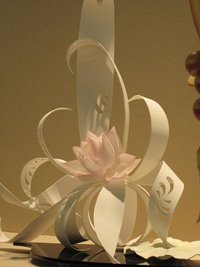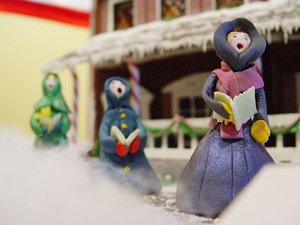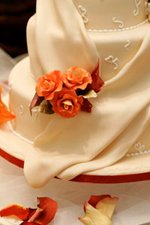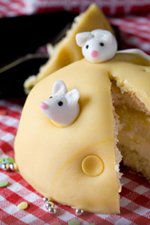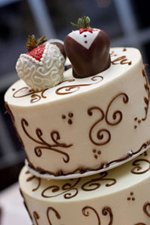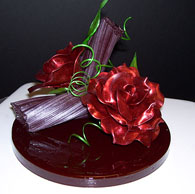Edible ClayFondant and Gum Paste and Marzipan... Oh my!The various edible clay methods, like fondant, gum paste, marzipan, and pastillage, are all related but have critical differences. The subtle ingredient distinctions result in substantially different characteristics... how firm they become, how easy they are to shape and work with, and of course their taste! I've included the most common edible clay or sugar craft methods here. These are the sugarcraft methods typically used to make edible cake decorations. Of course, these are the same types of edible decorations that can be used to turn a gingerbread house into a work of art.
Click on these links to jump right down to the edible clay method you're interested in:
What is Pastillage?
What is Gum Paste?Gum Paste is basically pastillage with gum tragacanth (or, alternatively, Tylose powder) added, allowing more time to work before the creation hardens. It dries fairly rigid (less than pastillage but far more than fondant.)
How to Make Gum Paste What is Fondant?Fondant is tastier and softer than the other edible clays. It holds its shape well, but will never harden completely. It remains maleable much longer than its counterparts and hardens only to a soft clay consistency.
Most professional bakers use fondant for covering cakes and making large decorations that will be eaten, and use gum paste for smaller, more intricate decorations. Fondant is found in the center of many candies, like chocolate buttercream-filled candy or the white part of a chocolate-covered cherry (a reaction with the cherry causes the fondant to liquefy a bit, making it runny.) How to Make FondantFondant Recipes Working with Fondant Photos of Fondant and Gum Paste Creations What is Sugar Paste?Sugar Paste is usually assumed to mean gum paste, but there are certainly people who use the term to mean fondant. Since gum paste and fondant have such striking differences, it's best to use these terms to avoid confusion. What is Marzipan?Marzipan is a sweet paste made from ground almonds that makes a smooth frosting or decadent filling. Marzipan is pricier than the other edible clays on this page and is considered the tastiest of all. It's considered best for modeling shapes such as fruits and figures for candies and yummy, edible cake decorations.
You can dye marzipan in batches or hand-paint the end result shapes (with food dyes of course.) Since it does not start out bright white, like fondant or gum paste, it does not take color quite as easily as the others. How to Make Marzipan Molded and Dipped Chocolate?Molded chocolate is not really a "clay" but it IS yet another way to make decorations for gingerbread houses as well as cakes. You simply melt chocolate and then pour it into molds that have the desired shapes. You can only add colorful details by adding the outermost color to the mold first (I often apply the most intricate details with a toothpick) and then pouring the background colors of chocolate in after the details have hardened. You can't get quite as elaborate or creative with molded chocolate as with the other edible clays since you need an appropriate mold. This can be a perfect way to make something you're repeating over and over again though (like reindeer, trees, snowmen, or other common figures.) And, of course, they end up yummy!
What is Pulled Sugar, Blown Sugar, and Cast Sugar?Cast, pulled, spun, poured, and blown sugar are the trickiest of the professional pastry chef techniques for intricate decorations. The process involves boiling a mixture of sugar, water, glucose, and cream of tartar, pouring it out onto a greased slab to cool slightly, and then pulling it out to form a glossy sheen. A heat lamp is used to keep the sugar flexible while working with it. Pouring sugar is the same except that it's poured straight out of the pan into molds. You can purchase molds or cast your own out of plasticene, which is found in most hobby stores.
How Edible is Edible Clay?While all of these modeling materials are "technically edible," some taste FAR better than others. In fact, some are really not intended to be tasted at all! Gum Paste is really designed for making intricate decorative items for cakes (or gingerbread houses of course!), but not necessary to be eaten. While it's technically edible, it's not really palatable. You never want to cover a cake with gum paste. Use fondant instead. Photos of Edible Clay CreationsPhotos of all kinds of edible creations
Return Home from this edible clay page. |
Free NewsletterGingerbread Patterns
Search This Site

Custom Search
|
|||||||||||||
|
Enjoy This Site?
Then why not use the buttons above to add us to your favorite bookmarking service? |
||||||||||||||
|
| HOME
| Contact Us
| About Us
| Disclaimer
|
| Privacy Policy
| Compensated Advertising
|
Return to top |
||||||||||||||
|
All Rights Reserved. | ||||||||||||||
